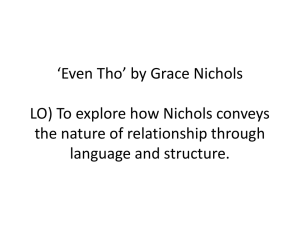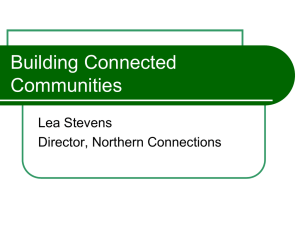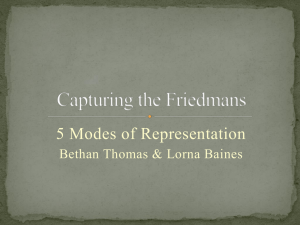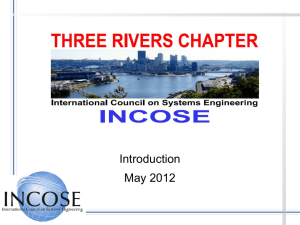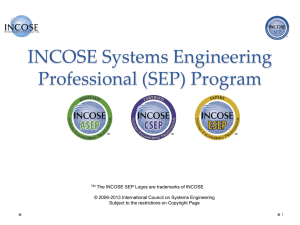Architectural Patterns for Self-Organizing Systems-of-Systems
advertisement
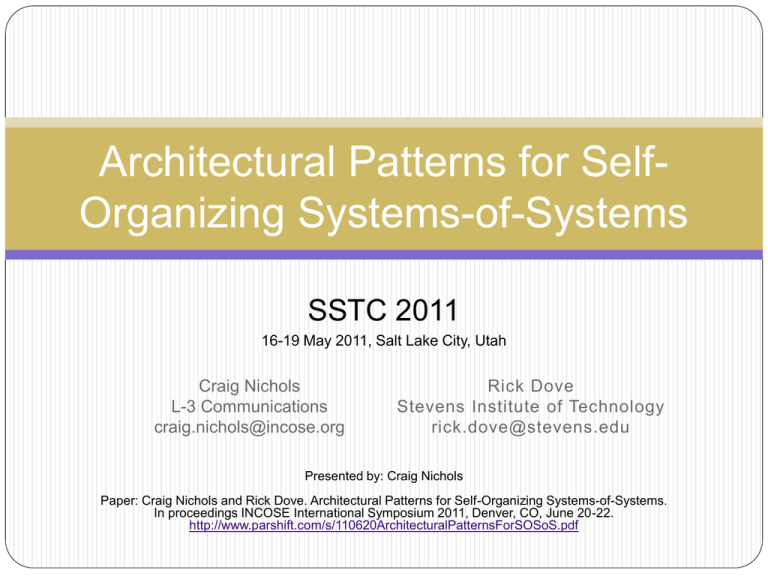
Architectural Patterns for SelfOrganizing Systems-of-Systems SSTC 2011 16-19 May 2011, Salt Lake City, Utah Craig Nichols L-3 Communications craig.nichols@incose.org Rick Dove Stevens Institute of Technology rick.dove@stevens.edu Presented by: Craig Nichols Paper: Craig Nichols and Rick Dove. Architectural Patterns for Self-Organizing Systems-of-Systems. In proceedings INCOSE International Symposium 2011, Denver, CO, June 20-22. http://www.parshift.com/s/110620ArchitecturalPatternsForSOSoS.pdf Overview Introduction Self-Organization Definitions Characteristics Systems-of-Systems Self-organizing examples Self-organizing patterns Conclusions Q&A? 2 craig.nichols@incose.org & rick.dove@stevens.edu attributed copies permitted Purpose Establish a basic understanding of self-organization within an SoS context, suggest a set of necessary self-organizing characteristics, and identify candidate architectural patterns, which can be used to address contemporary challenges. 3 craig.nichols@incose.org & rick.dove@stevens.edu attributed copies permitted Why do we care? Contemporary adversaries intelligent, multi-agent, self-organizing, systems-ofsystems with swarm intelligence, tight learning loops, fast evolution, and dedicated intent Broad capability needs Benefit of SE principles and evolutionary delivery Systems Engineering Guide for Systems-of- Systems Developing and evolving SoS architecture Monitor and assess change 4 craig.nichols@incose.org & rick.dove@stevens.edu attributed copies permitted SAREPH Architectural principles for agile design Self-organizing Most important and necessary characteristic Adaptable Tactics Reactive Resilience Evolving Strategies Proactive Innovation Harmonious Operation 5 craig.nichols@incose.org & rick.dove@stevens.edu attributed copies permitted Self-Organization Defined increased order where internal organization becomes more complex without outside intervention the generation of global structure resulting from positive and negative feedback of local interactions of independent agents adaptation of one’s structure to fit the environment 6 craig.nichols@incose.org & rick.dove@stevens.edu attributed copies permitted Self-organizing Characteristics Common purpose—the primitive needs that 7 motivate actions Conditional dependency—dependency driven through interconnectivity of participants Situation awareness— perception, correlation, projection Adaptability—readily capable to adjust Autonomy—ability to make independent decisions Whole-part relationship—belonging to something bigger craig.nichols@incose.org & rick.dove@stevens.edu attributed copies permitted Systems-of-Systems a set or arrangement of systems that results from independent systems integrated into a larger system that delivers unique capabilities Systems with independent purpose Systems with complimentary capabilities Higher-level objective(s) New relationships (organizational & structural) Unique behavior emerges 8 craig.nichols@incose.org & rick.dove@stevens.edu attributed copies permitted Ushahidi 2007 Kenya Election Subsequent crisis developed rioting, ethnic attacks, and general anarchy Ory Okolloh identified the need Independent testimony from populace Volunteer corroboration Correlation engine Mapped depiction of events 9 craig.nichols@incose.org & rick.dove@stevens.edu attributed copies permitted Ushahidi Characteristics 10 SO Characteristic Ushahidi Manifestation Common Purpose • Crisis support • Initially to track incidents of violence Conditional Dependency • Events reported by local observers • Events verified by volunteers • Relief provided to victims Situation Awareness • Local observers report via SMS, email or web • Correlated events reported via web Adaptability • Any event can be reported; observer selected • Adapted to any crisis e.g. 2010 Gulf spill Autonomy • Local observers decide when and what to report • New deployments take minimal time Whole-Part Relationship • Inherent in SoS craig.nichols@incose.org & rick.dove@stevens.edu attributed copies permitted Swarm Robotics—Mine Sweepers Large numbers of small robots Each has simple capabilities Each exhibits independent decisions Coordination Rules of engagement Communication (e.g. SRR & LRR) Emergent swarm behavior (group effort) 11 craig.nichols@incose.org & rick.dove@stevens.edu attributed copies permitted Swarm Robotics Characteristics 12 SO Characteristic Swarm Robotics Manifestation Common Purpose • Locate and disarm all mines in a given area Conditional Dependency • Operational behavior or rules of engagement; robots must respond to recruitment messages Situation Awareness • Short Range Recruitment messages • Long Range Recruitment messages Adaptability • Robust with respect to individual robot failures Autonomy • Independent robotic decisions; robots randomly search and independently respond Whole-Part Relationship • Inherent in SoS craig.nichols@incose.org & rick.dove@stevens.edu attributed copies permitted SOLE Research by Sugata Mitra Hole in the Wall Project New Castle biotechnology experiment Gateshead group experiments Small group of self-motivated children Internet access “Granny Cloud” 13 craig.nichols@incose.org & rick.dove@stevens.edu attributed copies permitted SOLE Characteristics 14 SO Characteristic SOLE Manifestation Common Purpose • Topic of interest • Human curiosity Conditional Dependency • Small Groups • “Granny Cloud” • Peer pressure Situation Awareness • Computer/Internet Adaptability • Internet makes any educational topic possible • Children self-organize small groups “at will” Autonomy • Children decide how to learn Whole-Part Relationship • Inherent in SoS craig.nichols@incose.org & rick.dove@stevens.edu attributed copies permitted Crowd Sourced Incident Reporting 15 craig.nichols@incose.org & rick.dove@stevens.edu attributed copies permitted 16 Name Crowd Sourced Incident Reporting (CSIR) Context Incident information is needed from a large population potentially scattered across a broad geographic area Problem Details of a crisis event are needed, but sending in a team of specialists does not scale and they are subject to the crisis at hand Forces • Individuals within the population decide what to report, but their reports may not be relevant or accurate • Succinct relevant information is desired but unconstrained reporting resources leads to numerous reports • Full coverage is desired but the geographic area may be vast and hostile Solution Create the ability for the population within the crisis zone to submit first hand witness reports and support the ability to correlate the data Examples • Ushahidi • Citizens monitor Gulf Coast after oil spill • Amber Alert craig.nichols@incose.org & rick.dove@stevens.edu attributed copies permitted CSIR Static Structure Coorelation Engine generated from > * * < reports * Crisis Report Witness Testimony * * v describes * Crisis Event * involves > triggers > Incident * Person * Population * * * * * Location 17 craig.nichols@incose.org & rick.dove@stevens.edu attributed copies permitted Geographic Area Swarm Discovery & Cooperation Agent Locates & Alerts Objects of Interest Sparsely Located Deploy Agent Swarm 18 craig.nichols@incose.org & rick.dove@stevens.edu attributed copies permitted Cooperative Dismantles 19 Name Swarm Discovery and Cooperation Context One or more objects of interest must be located in a sparse environment, and the mission objective cannot be accomplished effectively by any one individual. Problem Locate objects in a sparse environment and perform some cooperative operation on them (e.g. transport or disarm). Forces • Time pressure to accomplish mission vs. cost of multiple resources. • Time pressure to find an object vs. search area size. • Risk of search-agent loss vs. cost of redundancy. Solution Randomly deploy a large number of simple agents across the target space. Each agent searches for the object of interest, which can be detected using individual sensors. Once found, the discovering agent notifies others to assist in actions on the target. Examples • • • • Mine detection Multi-agent search & transport Search and rescue Foraging ants craig.nichols@incose.org & rick.dove@stevens.edu attributed copies permitted SDC Static Structure Swarm dismantle * * < discover * Agent Object of Interest * * * searches * Location 20 craig.nichols@incose.org & rick.dove@stevens.edu attributed copies permitted Environment notifies Collaborative Learning 21 craig.nichols@incose.org & rick.dove@stevens.edu attributed copies permitted 22 Name Collaborative Learning Context A group of individuals, potentially uneducated, need to learn a new topic. They need to be motivated to overcome perceived hindrances. They have access to fundamental tools (e.g. computer and Internet) to complete the objective. Problem A group of individuals are tasked, or take initiative, to learn a specific topic without explicit educational instruction. Forces • Peer collaboration in conflict with peer competition. • Natural human learning curiosity vs. availability of learning objectives and situational exposure. • Teacher expertise vs. shortage of teachers. Solution Small teams (3-4) with a common learning interest obtain, or are given, access to necessary tools (e.g., Internet search). Mediators may be accessible to assist and answer questions, though not necessarily expert on the topic. Examples • SOLE • Hole in The Wall • Teaching methods craig.nichols@incose.org & rick.dove@stevens.edu attributed copies permitted CL Static Structure Granny Cloud Learning Tool Team Guide facilitates access Computer 3..4 * * Granny * * Person Interest shared by collaborate * * learn * Topic < based on 23 craig.nichols@incose.org & rick.dove@stevens.edu attributed copies permitted * Internet Summary Six necessary characteristics for self- organization: common purpose, conditional dependency, situation awareness, adaptability, autonomy, whole-part relationship Candidate patterns: Crowd sourced incident reporting Swarm discovery and cooperation Collaborative learning 24 craig.nichols@incose.org & rick.dove@stevens.edu attributed copies permitted Next Steps Delve deeper into each pattern and provide detailed analysis and additional examples Map patterns to contemporary problems; apply theory to the real world Identify and document additional self-organizing patterns 25 craig.nichols@incose.org & rick.dove@stevens.edu attributed copies permitted Q&A 26 craig.nichols@incose.org & rick.dove@stevens.edu attributed copies permitted References 1. About Ushahidi. n.d. Ushahidi. http://www.ushahidi.com/about (accessed August 18, 2010). 2. Ashby, W. Ross. 1962. Principles of the Self-organizing System. Principles of Self-organization, ed. H. Von Foerster and G. W. Zopf Jr., 255-278. London: Pergamon Press. 3. Azani, Cyrus. 2009. An open systems approach to system of systems engineering. In System of Systems Engineering, Innovations for the 21st Century. Ed. Mo Jamshidi, 21-43. Hoboken, New Jersey: John Wiley and Sons, Inc. 4. Boardman, John, and Brian Sauser. 2008. Systems Thinking. Boca Raton, Fl. Taylor & Francis Group, LLC. 5. Bollazzi, Martin and Flavio Roces. 2011. Information Needs at the Beginning of Foraging: Grass-Cutting Ants Trade Off Load Size for a Faster Return to the Nest. PLoS ONE 6(3): e17667. doi:10.1371/journal.pone.0017667. 6. Camazine, Scott, Jean-Louis Deneubourg, Nigel Franks, et.al. 2001. What is Self-organization. 1-13. Self Organization in Biological Systems. Princeton University Press. 7. Chaos Computer Club. n.d. http://www.ccc.de (accessed October 9, 2010). 8. Davidson, Max. 2010. Teaching: Inspiring British children, Slumdog style. Telegraph.co.uk. http://www.telegraph.co.uk/education/7585505/Teaching-Inspiring-British-children-Slumdog-style.html (accessed October 28, 2010). 9. Davis, 1993. Collaborative learning: Group Work and Study Teams. In Tools for Teaching. San Francisco: Jossey-Bass. http://teaching.berkeley.edu/bgd/collaborative.html (accessed October 28, 2010). 10. Defense Acquisition University. May 5, 2010. Defense Acquisition Guidebook. http://at.dod.mil/docs/DefenseAcquisitionGuidebook.pdf (accessed June 6, 2010). 11. Department of Defense. Instruction 5000.02. 2008. 27 craig.nichols@incose.org & rick.dove@stevens.edu attributed copies permitted 12. De Wolf, Tom and Tom Holvoet. 2004. Emergence versus self-organizsation: Different concepts but promising when combined. Scribd. http://www.scribd.com/doc/22620289/Emergence-versus-selforganization-tom-de-wolf (accessed October 9, 2010) 13. DOD. 2003. The Defense Acquisition System. Department of Defense, DODD 5000.1. May 12. 14. DOD. 2008a. Operation of the Defense Acquisition System. Department of Defense, DODI 5000.2. December 8. 15. DOD. 2008b. Systems Engineering Guide for Systems of Systems, Version 1.0. Office of the Deputy Under Secretary of Defense for Acquisition and Technology, Systems and Software Engineering. August. www.parshift.com/Files/PsiDocs/PatternQualificationsForAgileSecurity.pdf 16. Dove, Rick. 2001. Response Ability. John Wiley and Sons, Inc. 17. Dove, Rick. 2010. Pattern Qualifications and Examples of Next-Generation Agile System-Security Strategies. 44th Annual IEEE International Carnahan Conference on Security Technology, San Jose, California, USA, 5-8 October, 2010. 18. Endsley, M. R. 2000. Theoretical Underpinnings of Situation Awareness: A Critical Review. In Situation Awareness Analysis and Measurement. ed. M. R. Endsley and D. J. Garland. Mahwah, NJ: Lawrence Erlbaum Associates. http://zonecours.hec.ca/documents/A2007-11399574.TheoricalUnderpinningsofSituationAwareness_ACriticalReview.pdf (accessed October 28, 2010). 19. Giridharadas, Anand. 2010. Africa’s gift to Silicon Valley: How to track a crisis. New York Times, Week in Review. http://www.nytimes.com/2010/03/14/weekinreview/14giridharadas.html (accessed September 29, 2010). 28 craig.nichols@incose.org & rick.dove@stevens.edu attributed copies permitted 20. Heylighen, Francis. 2008. Complexity and self-organization. Principia Cybernetica Web. http://pespmc1.vub.ac.be/Papers/ELIS-complexity.pdf (accessed July 28, 2010). 21. Hole in The Wall. 2009. About HiWEL. Hole-in-the-wall. Hole-in-the-wall Education Ltd. http://www.holein-the-wall.com/abouthiwel.html (accessed October 28, 2010). 22. Maslow, Abraham. 1943. A theory of human motivation. In Psychological Review no. 50: 370-396. 23. Mitra, Sugata. 2010. The child-driven education. Oxford: TED Global 2010. http://www.ted.com/talks/sugata_mitra_the_child_driven_education.html (accessed October 28, 2010). 24. Nichols, Craig. 2010. Report on architecture patterns for self-organizing systems-of-systems. Masters Project, Stevens Institute of Technology. 25. Office of the Deputy Under Secretary of Defense for Acquisition and Technology, Systems and Software Engineering. 2008. Systems Engineering Guide for Systems of Systems, Version 1.0. Washington, D.C. 26. Rodrıguez, Alejandro and James A. Reggia. 2005. Using Aggregate Motion in Multi-Agent Teams to Solve Search and Transport Problems. Proceedings Swarm Intelligence Symposium. 8-10 June 2005, pp 373-380. http://citeseerx.ist.psu.edu/viewdoc/download?doi=10.1.1.119.4347&rep=rep1&type=pdf (accessed August 18, 2010). 29 craig.nichols@incose.org & rick.dove@stevens.edu attributed copies permitted 27. Sahin, Ferat. 2009. Robotic Swarms as System of Systems. In System of Systems Engineering, ed. Mo Jamshidi, 482-519. Hoboken, NJ: John Wiley & Sons, Inc. 28. Sarıel, Sanem and H. Levent Akın. 2005. A Novel Search Strategy for Autonomous Search and Rescue Robots. D. Nardi et al. (Eds.): RoboCup 2004, LNAI 3276, pp. 459–466. 29. SOME Team. n.d. SOLE & SOME, Self Organizing Learning Environments & Self Organized Mediation Environments. http://solesandsomes.wikispaces.com/A+bit+about+SOLE+%26+SOME (accessed October 28, 2010). 30. Sutter, John D. 2010. Citizens monitor Gulf Coast after oil spill. CNN Tech. http://www.cnn.com/2010/TECH/05/06/crowdsource.gulf.oil/index.html (accessed August 18, 2010). 31. Traniello, James F. A. 1989. Foraging Strategies of Ants. Annual. Review Entomology. 34:191-210. 32. Wikipedia n.d. 2007-2008 Kenyan crisis. Wikipedia, The Free Encyclopedia. http://en.wikipedia.org/wiki/2007%E2%80%932008_Kenyan_crisis (accessed September 29, 2010). 33. ———. n.d. Amber Alert. Wikipedia, The Free Encyclopedia. http://en.wikipedia.org/wiki/AMBER_Alert (accessed August 23, 2010). 34. ———. n.d. Design Patterns (computer science). Wikipedia, The Free Encyclopedia. http://en.wikipedia.org/wiki/Design_pattern_(computer_science) (accessed 09 28, 2010). 35. ———. n.d. Fatawā of Osama bin Laden. Wikipedia, The Free Encyclopedia. http://en.wikipedia.org/wiki/Fat%C4%81w%C4%81_of_Osama_bin_Laden (accessed August 23, 2010). 30 craig.nichols@incose.org & rick.dove@stevens.edu attributed copies permitted Acronyms 31 Acronym Definition CSIR Crowd Source Incident Reporting DoD Department of Defense LRR Long Range Recruitment Q&A Questions & Answers SDC Swarming Discovery & Cooperation SE Systems Engineering SO Self Organizing SOLE Self-organized Learning Environment SoS System of Systems SRR Short Range Recruitment craig.nichols@incose.org & rick.dove@stevens.edu attributed copies permitted





